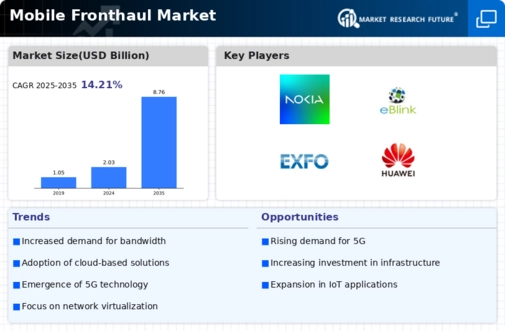Market Growth Projections
The Global Mobile Fronthaul Market Industry is poised for substantial growth, with projections indicating a market value of 2.03 USD Billion in 2024 and an anticipated rise to 8.76 USD Billion by 2035. This growth trajectory suggests a compound annual growth rate of 14.21% from 2025 to 2035, reflecting the increasing investments in mobile network infrastructure and the demand for advanced fronthaul solutions. As mobile operators adapt to the evolving landscape of telecommunications, the fronthaul segment is likely to play a critical role in supporting the next generation of mobile connectivity.
Emergence of IoT Applications
The proliferation of Internet of Things (IoT) applications is reshaping the Global Mobile Fronthaul Market Industry. With billions of devices expected to be connected in the coming years, the demand for reliable and low-latency fronthaul solutions becomes paramount. IoT applications, ranging from smart cities to industrial automation, require robust mobile networks to function effectively. As a result, telecom operators are compelled to invest in fronthaul technologies that can support the anticipated data influx. This trend not only drives market growth but also encourages innovation in fronthaul solutions tailored for IoT environments.
Government Initiatives and Policies
Government initiatives and policies play a pivotal role in shaping the Global Mobile Fronthaul Market Industry. Many countries are implementing strategies to promote the rollout of advanced telecommunications infrastructure, particularly in underserved areas. These initiatives often include funding programs, regulatory support, and incentives for private sector investment. As governments recognize the importance of connectivity for economic growth and social development, the fronthaul segment benefits from increased funding and policy support. This proactive approach is likely to accelerate market growth, ensuring that mobile networks can meet the demands of the future.
Adoption of Virtualized Network Functions
The Global Mobile Fronthaul Market Industry is witnessing a shift towards the adoption of virtualized network functions (VNFs). This transition allows telecom operators to enhance network flexibility and reduce operational costs. By virtualizing network components, operators can optimize their fronthaul architectures, enabling more efficient resource allocation and improved service delivery. The growing trend of network function virtualization is expected to contribute to the market's expansion, as it aligns with the industry's need for agility in responding to changing consumer demands. This evolution may further solidify the fronthaul segment's role in modern telecommunications.
Rising Demand for High-Speed Connectivity
The Global Mobile Fronthaul Market Industry experiences a notable surge in demand for high-speed connectivity, driven by the increasing adoption of 5G technology. As mobile operators seek to enhance user experiences, the fronthaul segment becomes crucial in delivering the required bandwidth. In 2024, the market is valued at approximately 2.03 USD Billion, reflecting the industry's response to the growing need for faster data transmission. This trend is expected to continue, as the market is projected to reach 8.76 USD Billion by 2035, indicating a robust growth trajectory fueled by the transition to advanced mobile networks.
Expansion of Mobile Network Infrastructure
The Global Mobile Fronthaul Market Industry is significantly influenced by the expansion of mobile network infrastructure. As urbanization and digitalization accelerate, telecom operators are investing heavily in upgrading their networks to support increased data traffic. This expansion is characterized by the deployment of fiber optic cables and advanced radio access technologies, which enhance the efficiency of fronthaul connections. The anticipated compound annual growth rate of 14.21% from 2025 to 2035 underscores the urgency of infrastructure development, as operators strive to meet the demands of an increasingly connected world.















Leave a Comment